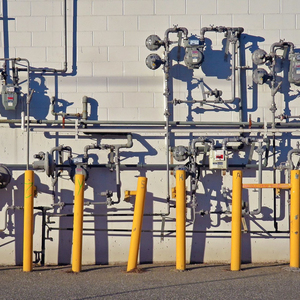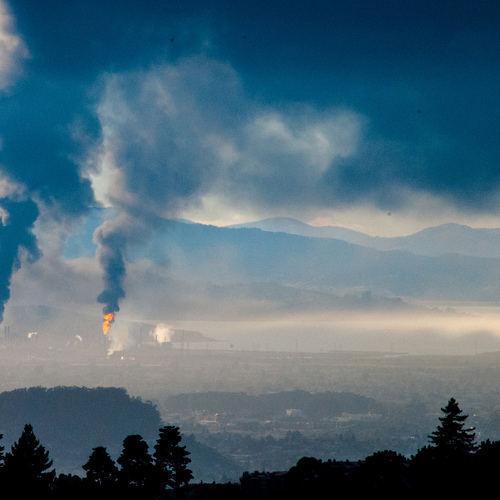
San Jose, the nation’s 10th largest city, has emerged as a climate leader in recent years, by becoming the biggest city in the United States to make almost all new buildings all-electric. But the city’s work isn’t done, as its leaders know. On Nov. 8, the City Council unanimously passed a resolution to go carbon neutral by 2030.
The global climate crisis is here
The global climate crisis has already begun impacting millions of people. We are all feeling the effects: rising temperatures, more frequent and intense flooding, extensive wildfires, and unpredictable extreme weather.
Just over the past year, residents of San Jose were hit by smoke from fires, record heat, heat-induced power outages, and drought. This will get worse if left unchecked. Projections for San Jose include threats from sea level rise and more frequent and severe heat waves. In San Jose as elsewhere, historically underserved communities are hit hardest. Communities of Black, brown, and Asian American residents in San Jose already bear higher asthma rates, greater exposure to extreme heat and air pollution, and more unaffordable energy costs. Climate change is making this worse.
Now, San Jose is acting to protect its residents. City action matters. Cities can innovate and move faster, often, than states and nations. And city action adds up. San Jose is one of 25 cities selected as part of the Bloomberg Philanthropies American Cities Climate Challenge: when the U.S. pulled out of the Paris climate accord, these cities said “we are still in,” and together— despite a pandemic—took significant action to reduce emissions and uphold those Paris commitments.
San Jose is ready, and residents will benefit
In 2018, San Jose’s City Council passed Climate Smart San Jose, a plan for reducing emissions across sectors by 80% by 2050. But the pace and the power of climate change has increased faster than we all expected. That’s why San Jose, like many other cities, declared a Climate Emergency in 2019—to avoid a tipping point into disaster, as climate change accelerates, so must the speed of the response.
San Jose’s city leaders showed that they are not merely declaring an emergency, they are acting on it, by passing this Carbon Neutral resolution.
San Jose is not the only city taking this step; Los Angeles recently became the nation’s largest city to do so. And while bold, San Jose’s new goal builds on a solid foundation. San Jose has been systematically addressing its two biggest sources of emissions: buildings and transportation. It’s gotten fossil fuels largely out of new buildings and is considering programs that equitably support reducing emissions in existing buildings, the source of a third of the city’s emissions. To make transportation more sustainable, it’s building out a nation-leading 400-mile bike network and won inclusion in the Delivering Zero Emissions Communities accelerator program to cut emissions from freight.
All these climate policies are making San Jose a safer, more affordable, and healthier place to live. For example, cutting freight emissions reduces air pollution, an especially heavy burden on residents of many underserved neighborhoods. Better bike lanes and public transit also help clean up the air and reduce traffic. More efficient appliances like heat pumps help cut energy costs. Climate-friendly infrastructure projects create local jobs.
Key components of reaching the goal
The biggest sources of emissions in San Jose are transportation and buildings. There are two areas here of particular interest.
Freight: The city is working to cut freight emissions from trucks. By focusing on freight emissions in particular, the city will take a significant step in reducing not only climate impacts but in reducing the many other environmental harms that are concentrated in historically disadvantaged communities.
Existing buildings: San Jose has done much to ensure new construction is energy efficient and all-electric. But meeting the resolution’s big goal will demand that San Jose leaders focus attention and resources on getting fossil fuels out of existing buildings—and doing it equitably, which means planning with the community, supporting building owners who need help, and helping local workers get the training needed to do these jobs. City staff are currently working with the Building Electrification Institute and community-based organizations to co-create a Building Electrification Plan—informed by community priorities—that should go before the City Council next year. The creation, passage, and funding of this plan will be critical to ensuring that San Jose’s approach to making buildings carbon neutral is thoughtful and equitable.
Though the National Resources Defense Council and partners urged the city to be clear that carbon neutral meant zero emissions, city staff said that at this point the resolution would likely include offsets, meaning it is “net zero” rather than zero. However, it will still require dramatic cuts in emissions.
To reach the goal, San Jose will need to tackle fuel use in industry as well as buildings and transportation; the use of grid-supplied energy; treatment of waste generated within the city boundaries; and the deployment more zero-emission technologies, such as heat pumps for heating and cooling, and electric vehicles.
This is just the start. There will need to be a more detailed plan to meet the goal, and leaders will need to find the funding to reach it. The resolution commits the city to improving existing actions, evaluating the resources needed, and doing so in collaboration and partnership with environmental justice communities.
Cities in the American Cities Climate Challenge offer some excellent examples for how to move forward. For example, Denver’s approach included a thoughtful plan, real community involvement, and a funding measure to achieve climate goals while prioritizing equity.
With this vote—and with the plan and funding to reach the goal—San Jose’s Mayor Liccardo and City Councilmembers will join the leaders across the nation and world who were first responders in a time of true emergency.
Elilzabeth Stampe is a city strategist with the American Cities Climate Challenge. This blog, co-written by Sarah Elkotbeid, originally appeared at the National ResourcesDefense Council’s Expert Blog.
Weekly Newsletter
Get building science and energy efficiency advice, plus special offers, in your inbox.















4 Comments
So they are significantly increasing the cost of living to all residents, which hurts the poor and lower middle class the most....
All based on what again??
You might have missed this paragraph:
"All these climate policies are making San Jose a safer, more affordable, and healthier place to live. For example, cutting freight emissions reduces air pollution, an especially heavy burden on residents of many underserved neighborhoods. Better bike lanes and public transit also help clean up the air and reduce traffic. More efficient appliances like heat pumps help cut energy costs. Climate-friendly infrastructure projects create local jobs."
A lot of the initiatives actually lower the real cost of living, and some especially for the poor and lower middle class, for example an investment in mass transit will make car ownership unnecessary for a lot of people or a family can get by with one car instead of two. Just designating a bus lane doesn't cost much at all and can have a similar impact. More people using transit = less pollution and less cost for a commuter.
You believe that it won't cost anything ;) that's pretty cute... don't be foolish, all that money isn't going to fall out of the sky, its going directly on the backs of the taxpayers.
Restrictions on trucking mean higher costs for groceries, and every other item needed for day to day life, hitting those who can't afford to travel out of the city for lower costs/higher quality goods the hardest, even those who can afford to travel are hurt.
Infrastructure projects are put to bid, and done by contractors who specialize in that work (and usually pay their employees well) but they bring the employees with them, they don't hire new locals for every job.
I've got quite a few friends who work road construction, they work between 45 min to 4-1/2 hours (each way) from home.
Meh, When I last visited San Jose I saw a lot of young, lazy people aka "poor" spending their day on main street getting high. The stench from the smoking was almost unbearable.
Log in or create an account to post a comment.
Sign up Log in